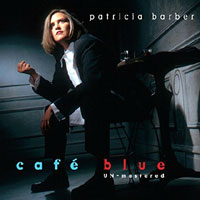Patricia Barber • Café Blue Un-Mastered Premonition Records 90760-5  ll of
Patricia Barber’s releases for Premonition Records have been sonic spectaculars.
I’ll leave it up to each individual listener to decide on their musical worth;
I’ve always found them highly interesting. It matters not which format you choose --
CD, LP or SACD: you’ll be rewarded with superb sound. Café Blue may be
Patricia Barber's most popular and best-regarded release. I have both the original
Premonition LP and Mobile Fidelity SACD. They are each a superb example of their
particular format, and I enjoy listening to both very much. ll of
Patricia Barber’s releases for Premonition Records have been sonic spectaculars.
I’ll leave it up to each individual listener to decide on their musical worth;
I’ve always found them highly interesting. It matters not which format you choose --
CD, LP or SACD: you’ll be rewarded with superb sound. Café Blue may be
Patricia Barber's most popular and best-regarded release. I have both the original
Premonition LP and Mobile Fidelity SACD. They are each a superb example of their
particular format, and I enjoy listening to both very much.
Why, then, 22 years after its initial release and with three superb issues of this album available, did Premonition Records feel the need to reissue Café Blue once again? The cover will give you a big clue -- the word "un-mastered." A reading of the accompanying press materials (which are also reproduced as an insert within the liner notes) explains Super Audio Center’s Gus Skinas's reasoning: "My preference is to get as close to the original mix master as possible. Often the original mix master needs little help or nothing at all to make me very happy. This is particularly true with records recorded and mixed by the great recording engineers, which is certainly the case with this album." (Café Blue was recorded and mixed by the great Jim Anderson.) Skinas further goes on to say, "The label (Premonition) supported my approach, approving this 'un-mastered’ release of Café Blue and allowing the listener to hear what I heard: a version of this great recording that is as close to what happened in the studio as possible." We audiophiles know the music on this album -- it has been played to death in stores and at shows -- an eclectic mix of pop and jazz, including a number of Barber originals. Barber is on piano and vocals, Michael Arnopol is on bass, John McLean plays guitars, and Mark Walker handles percussion. Does Skinas’s view and his un-mastering really create a version of this audiophile classic to warrant purchasing it again? He certainly seems to be on to something here. There is a clarity to this release that eludes all the others -- and, yes, I’m including the LP in this statement. It’s as if, to borrow that old audio cliché, the window into the sound has not just been cleaned to within an inch of its life but opened wide. When I compare either of my two other copies (especially the MoFi SACD) to this SACD, I can’t help but sit up, lean in and be amazed at how much closer to the musicians this "un-mastered" disc brings me. Barber’s voice is both closer and far more vivid. The finger snaps on the opening of "Ode To Billie Joe" are far more realistic. The bass on the same track sounds closer to what you would hear if you were sitting right next to Arnopol during the recording session. When Skinas says "It’s unlike any other version of Café Blue released to date," he’s not kidding. There is no sonic aspect of this SACD that is not an improvement over any previous release. If Café Blue is a favorite of yours, you have to hear what improvements have been made here. While a good mastering engineer can work sonic wonders, sometimes it takes someone with the guts to take a more hands-off approach to allow the recording to truly bloom. I passed on Skinas's thoughts to a friend of mine who is a mastering engineer, and he basically agreed that the better the recording, the less the mastering engineer has to do to produce great sound. Gus Skinas and the folks at Premonition Records have
shown what’s possible by allowing a great recording engineer’s efforts to speak
for themselves and helping to knock down our preconceptions of what’s necessary for a
great recording to sound its best. Bravo! |
